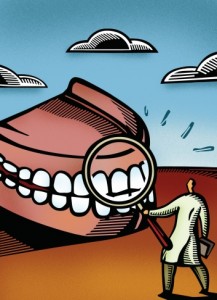 Working in dental office you hear a lot of excuses for not brushing and flossing regularly. The American Academy of Periodontology has come up with an informative list of excuses and a solution for each. By taking control of your oral health at home you are not only maintaining a healthy smile but also contributing to your overall well being.
Working in dental office you hear a lot of excuses for not brushing and flossing regularly. The American Academy of Periodontology has come up with an informative list of excuses and a solution for each. By taking control of your oral health at home you are not only maintaining a healthy smile but also contributing to your overall well being.
1. My hands are too big to fit in my mouth and I have no dexterity.
If dexterity problems are the excuse, there are many options available. Floss picks and floss holders are great inexpensive solutions, a power floss holder or electric toothbrush with a floss attachment can also solve this problem. A dental water jet like a Waterpik is also great for people who have trouble using dental floss.
2. Floss pushes food further into the gingival pocket.
Most people think dental floss is used to remove and loosen food between the teeth, but it’s primary function is actually removing the invisible film of bacteria that constantly forms between teeth. Floss cleans about 30 percent of the tooth’s surfaces in places that a toothbrush simply cannot reach.
3. When I floss my gums bleed.
Floss is not what actually is causing your gums to bleed, but not flossing daily could. If you floss on a routine basis you will not see blood. That’s because flossing may help prevent gingivitis, the mildest form of periodontal disease. Gingivitis causes the gums to redden, swell, and bleed easily. Gingivitis is often caused by inadequate oral hygiene and can be reversible with professional treatment and good oral home care.
4. My teeth are cleaned professionally twice a year, so I don’t have to brush and floss at home.
It’s important to get your teeth cleaned and examined twice a year, but a daily at home oral hygiene routine is equally important. When plaque is not removed daily, it can turn into a hard substance called calculus/tartar in less than two days, Daily cleaning helps minimize calculus formation and may even reduce the frequency and cost of your dental office visits.
5. Brushing and flossing take too long.
Thorough brushing and flossing takes less time than shaving or applying make-up.
6. Brushing and flossing get in the way of my family time.
The truth is not brushing and flossing can actually take away from family time. Research suggest that periodontal disease can pass through saliva, common contact of saliva through family time such as kissing my put your loved ones at increased risk for contracting periodontal diseases and more trips to the dentist.
7. Losing teeth is a natural part of aging anyway, so brushing and flossing won’t help.
The image of a grandma and grandpa’s teeth in a glass is becoming a thing of the past. More people are keeping their natural teeth longer with brushing and flossing.
8. My teeth are too tight for the dental floss.
If you have tight spaces between your teeth, polymer floss with the ADA seal of approval may slide in between your teeth much easier.
9. I damage my gums when I floss.
If the correct flossing technique is being used, your gums will not be damaged. Read the guide below for the correct methods of brushing and flossing. Remember, you can always ask your dental care provider, such as a periodntist like Dr. Silvera about the correct techniques of maintaining healthy oral hygiene at home.
How to Brush and Floss
Now that we’ve overcome the most common excuses for not brushing and flossing, let’s review the correct techniques.
Start with 18 inches of dental floss and then wind the majority of the floss around your middle finger and the remainder around one of the middle fingers of your other hand. Gently insert the floss between your teeth using a back-and-forth motion, guiding the floss with your forefingers. Guide the floss to the gumline and curve the floss into a C-shape. Slide it into the space between the gum and tooth until you feel light resistance. Repeat this process between every tooth and don’t forget the back sides of your back teeth.
Begin brushing your teeth by cleaning all outside surfaces with your toothbrush at a 45 degree angle where your gums and teeth meet. Gently move the brush back and forth while maintaining a 45 degree angle. Dr. Silvera always recommends a tooth brush with extra soft bristles. Apply light pressure to get the bristles between the teeth and into line where your gums meet your teeth. Use this same method on the inside of the back teeth. When cleaning the inside surfaces of the upper and lower front teeth, hold the brush vertically. Make several gentle back and forth strokes over each tooth and it’s surrounding gum tissue. To clean the biting surfaces, use short gentle strokes. Do not forget to brush your tongue, a tongue scraper can help you out here as well.
The source of this data is the perio.org October 2004 AAP Patient Page titled “Brushing and Flossing “Excuse Busters” to the Rescue”. To find the original article and for more information please visit: www.perio.org

Thanks for your time for another fantastic post. Where else could anyone get that kind of information in such a perfect way of writing? I have a presentation next week, and I am on the look for such information. My kindest regards, Holly.
I gotta bookmark this web site it seems very useful handy